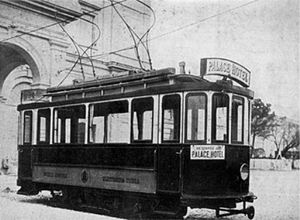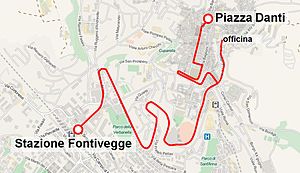Trams in Perugia
 |
|
| Overview | |
|---|---|
| Locale | Perugia, Umbria, Italy |
| Number of lines | 1 |
| Operation | |
| Began operation | 1899 |
| Ended operation | 1943 |
| Operator(s) | Società Anonima Elettricità Umbra (1899-1929) Società Unione Esercizi Elettrici (1929-1943) |
| Number of vehicles | 8 powered trams 4 unpowered tram trailers 1 coal trailer 2 mail trailers |
| Technical | |
| System length | 4.24 km (2.63 mi) (after 1932 3.9 km (2.4 mi)) |
| Track gauge | 1 Meter |
| Electrification | 550 V DC overhead lines |
The Perugia Tramway opened in 1899, which was the same year as that in which electric street lighting came to the city. The purpose of the Tramway was to link the historical city centre with the city's railway station, some 3 km away down the hill.
The Mussolini government became very keen on trolleybuses, and in October 1943 Perugia's tramway was replaced with a bus service which would last till 1975.
Inspiration was drawn from the experience of Italy's first electrically powered tramcar introduced on the (originally horse-powered) earlier in the 1890s. A contract for the construction of the Perugia tramline was awarded on 10 April 1899 to the "Napoleone Pimpinelli" company, which executed the work under the supervision of Berlin based Siemens & Halske. The tramway construction was part of a larger project of urban modernisation which also included an aqueduct and an electricity supply network. Work progressed speedily and the tramway was formally opened less than six months later, on 20 September 1899, in the presence of the minister and future prime minister Antonio Salandra. At the time when the tramcars were delivered to the city's main station they had to be delivered to the storage location using ox carts, and until 1901 the service provided was intermittent because of constant interruptions to the electric power supply.
The service was operated by Società Anonima Elettricità Umbra (SAEU), a company operated by the German Siemens-Shukert group: SAEU was also the company that had taken care of the city's switch-over from gas lighting to electric lighting. The new tramway was not universally welcomed, since the city centre retains its Medieval street plan, which meant that even on the central Corso Vannucci (street) where tram rails were laid, they sometimes passed unnervingly close to peoples' shops and homes. On the other hand, the hill-top location of the city centre meant that children, periodically interrupted by a passing tram, could enjoy rolling and racing bowling balls down the tracks.
The first timetables gave a journey time between the station and the city centre, and this proved sustainable not withstanding some vocal protests about the perceived danger the stability of the city's buildings from the vibrations of the trams rattling past. There were also sometimes journeys involving good wagon from the national rail service being towed into the centre by the municipal trams. (It was not possible for standard Italian railway locomotives to operate on the tramway because the gauge of the tramway was narrower than the national railway system's standard gauge.)
...
Wikipedia

